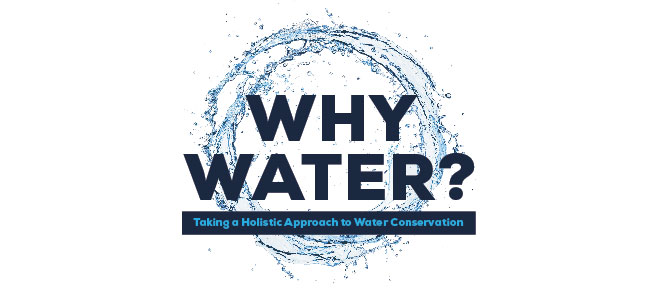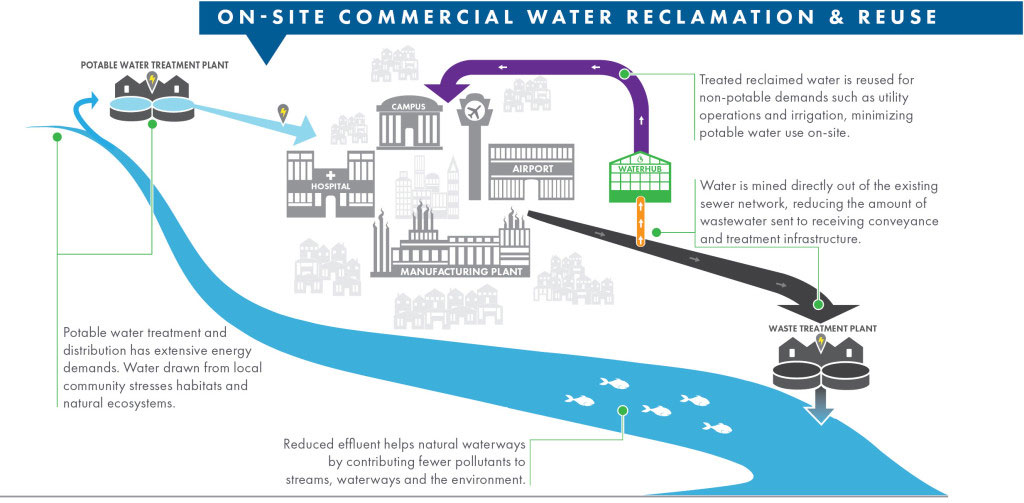
As many of you know water is one of our most valuable resources that data centers use a lot. There is only a finite amount of water available. Only about three percent of Earth’s water is freshwater. Of that, only about 1.2 percent can be used as drinking water; the rest is locked up in glaciers, ice caps, and permafrost, or buried deep in the ground. However, there is plenty of water available if it is managed properly and looked at holistically, characterized by comprehension of all parts of water are intimately interconnected and explainable only by reference to the whole. It is philosophical, but without water we will be thinking about our existence in a fundamental way. The following article is an expanded check list of what can be done now as well as through long term planning. The best approach is to research and implement during the construction process for the best value, but if not plan it out for the future.
BENEFITS OF WATER CONSERVATION
Water sources are the key to becoming sustainable and resilient. Not only is there the cost savings of using water properly, but even more of a concern for the existence of your business there is the concern in bringing in new business to the area. Is there enough water to sustain the community and if not, how much will it cost to make sure you have the water you need?
MAKE A LIST
Biomimicry is a practice that learns from and mimics the strategies found in nature to solve human design challenges — and find hope along the way.
The sources in green have been proven to work. Their benefit to your site are based on climate, location and building design. New construction makes cost and construction much easier, however water use should be discussed from the first day of planning to best incorporate site, building and plumbing. The sources in red especially wells have in many areas an unknown quantity and with competition with agriculture can go dry with a prolonged drought.
By listing your uses and sources you can realize how to start to manage all your water properly.
After listing your issues bring in professionals to meet with all departments using water for a charette (meeting). If designing a new building bring in these same people involved in designing each area, site design, plumbing, building structure, roof and drainage…, on day one. Many of your problems can turn into solutions. The next time it rains look at all of the free water going down the drain.
ENERGY BENEFITS
Energy benefits are regularly talked about as the Water/Energy Nexus, because water conservation can lead to a great deal of savings for energy. Using less hot water means less water to heat. Using Energy Star Products can save money and diverts less water from our rivers, bays, and estuaries, which helps keep the environment healthy. It can also reduce water and wastewater treatment costs and the amount of energy used to treat, pump, and heat water. This lowers energy demand, which helps prevent air pollution and climate change.
Pumping to upper floors and equipment by using variable speed pumps provide less energy and water use. Energy savings are dependent upon pump oversizing. When replacing a singlespeed pump, a variable speed pump might reduce energy use by 50% to 75% (Building America Retrofit Alliance). The energy utilities need to clean and distribute water is usually not considered and effects water costs. 75% of electricity used by Utility goes to cleaning and distributing water according to a Dept of Energy report sent to Congress. Reducing water use can help them as well.
CHECK WITH LOCAL AUTHORITIES
| SOURCES | BENEFITS | CONCERNS | BEST USE |
|---|---|---|---|
| Water Utilities | Clean & usually reliable | Old infrastructure failings | Drinking water and backup source |
| Rainwater | Very clean and can be stored for long periods of time, plentiful in many areas | Inconsistent, Climate Change | Toilets/Irrigation/Cooling Towers |
| Stormwater | Can be managed on-site through green Infrastructure | More and more permitting, Floods | Rain gardens/ Irrigation |
| Condensation | Very clean and free source | Legionella if not treated, however if used for cooling towers in closed loop will be treated for that system. | Toilets/Cooling Towers |
| Grey Water | Produced on-site for free | Requires a lot of maintenance, Permitting issues | Toilets/ Irrigation |
| Wells | Can be low cost installation | Mineral content/filtration, permitting, burden on surface water, in many areas over used. Climate Change | Toilets/Irrigation/Cooling Towers |
WATER BENEFITS
Water benefits are obvious if you use less water you pay for less water and if you manage all your water properly no floods, leaks or surprises. One way to do this is through WaterSense and Portfolio Manager for Commercial Buildings.
WaterSense provides facility managers, building owners, and other stakeholders with a variety of resources and initiatives to help them save water, energy, and operating costs. WaterSense labeled products meet EPA’s specifications for water efficiency and performance, and are backed by independent, third-party certification.
Use Portfolio Manager. You’ve heard it before: You can’t manage what you don’t measure. That’s why EPA created ENERGY STAR Portfolio Manager®, an online tool you can use to measure and track energy and water consumption, as well as greenhouse gas emissions. Use it to benchmark the performance of one building or a whole portfolio of buildings, all in a secure online environment.
You can use Portfolio Manager to manage the energy and water use of any building. All you need are your energy and water bills and some basic information about your building to get started. Are you designing a new commercial building? You can also use Portfolio Manager to set your energy use target and see how your estimated design energy stacks up against similar existing buildings nationwide. When you add your buildings, you’ll be joining nearly 25% of U.S. commercial building space that’s actively benchmarking in Portfolio Manager making it the industry-leading benchmarking tool. You’ll also be joining more than half of the Fortune 100®, half of the largest U.S. healthcare organizations, major league sports teams, colleges and universities, and entire cities.
REDUCING WATER USE BY BUILDING OCCUPANTS
Once you get all of the above in place implement an investment grade audit.
It takes time to do this properly and many facilities do not have the manpower to do this properly on their own. Hire a professional.
Most of the saving occurs if your fixtures are at current standards that can be achieved by performing maintenance programs regularly. Perform a walk though once a year after your initial audit and offer incentives such as gift cards to employees to notify about leaks and fixture problems.

IMPLEMENTING WATER MONITORING AT THE SYSTEM LEVEL
A water use monitoring/leak detection system is one of the most important products that can be added to a buildings management system. This technology can save time and money by automating some of the tasks needed in maintenance and data management by providing real time water monitoring with a host of IoT capabilities. Water monitoring systems are a necessity. There cost is discrepancy of the different systems available based on capabilities and features, however they do have an attractive pay back, because with water something bad will happen
sooner than later.

Capabilities may include:
CONSERVING WATER IN MECHANICAL SYSTEMS
CONDENSATION HARVESTING AND USE
Consider condensation collection to go back into the cooling system:
WASTEWATER REUSE
Water security, whether triggered by revolving drought or infrastructure failure, is a common theme across the United States. In light of these stresses, bulk water users, like college campuses and manufacturing centers are turning to water reclamation to recycle billions of gallons and save hundreds-of thousands of dollars each year. Water reclamation and reuse enhances water security creating a more resilient community by localizing water supplies. Examples of this include Google’s water reuse from a wastewater plant they built in Douglas County, GA and Emory University’s WaterHub in Atlanta.
DECENTRALIZED (ON-SITE) WATER REUSE PROVIDES NUMEROUS BENEFITS, SUCH AS:
LIMITING USE OF POTABLE WATER FOR NON-POTABLE USE.
The only water that needs to be from a potable source (utilities) is drinking water, water needed to produce meals and showers. The issue in retrofitting existing buildings seems to be cost, but
look at the lifecycle investment. It can make cents!
Check with local authorities and professional organizations for more information!
Use this a reference guide to make your property more efficient and resilient. Hire a professional to help. The money spent
will be money saved.
Steve Williams is The Water Guy of Pluvial Solutions. He can be reached at pluvialsolutions@gmail.com.
Read Other Articles
(You Must Be Logged In to Continue…)